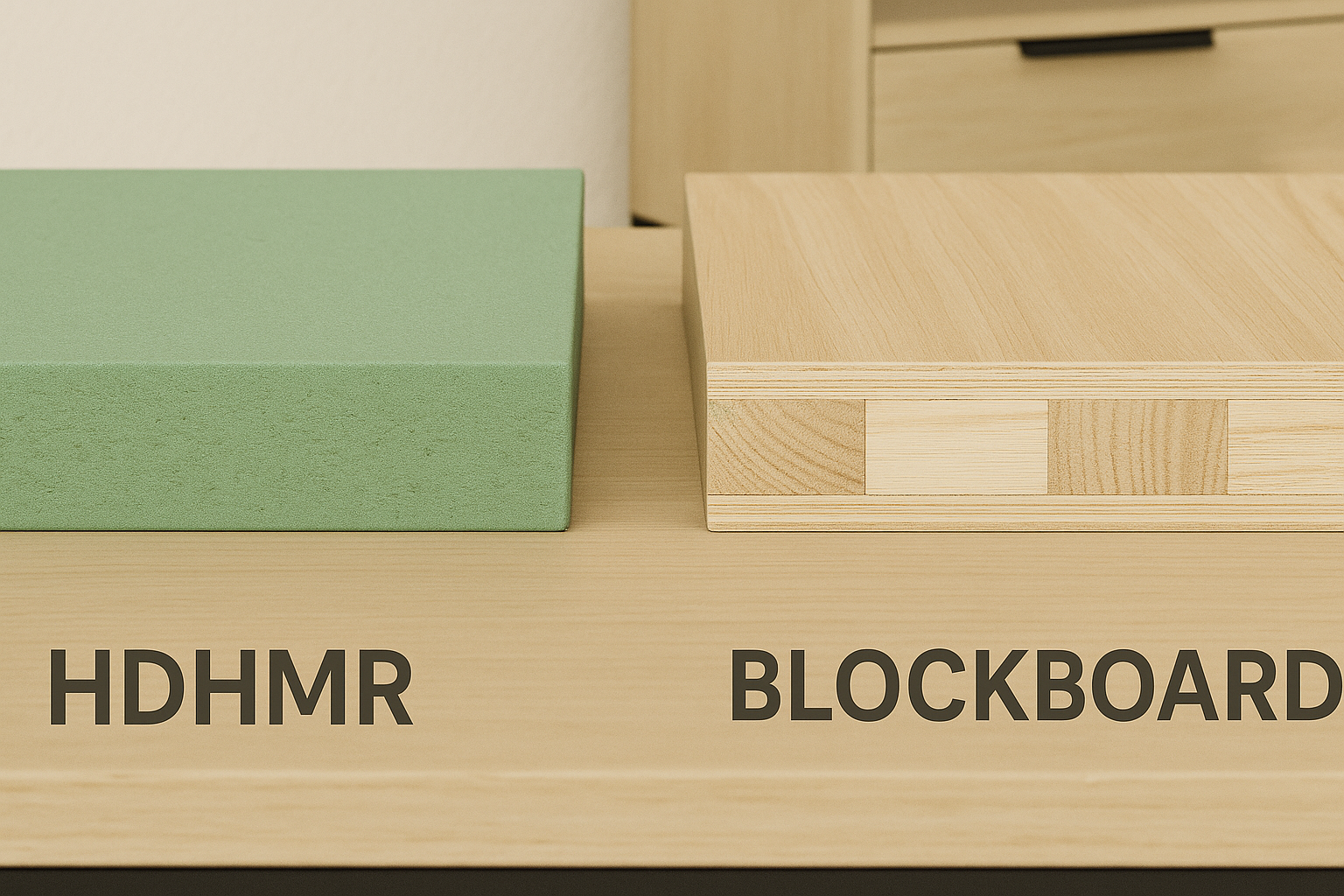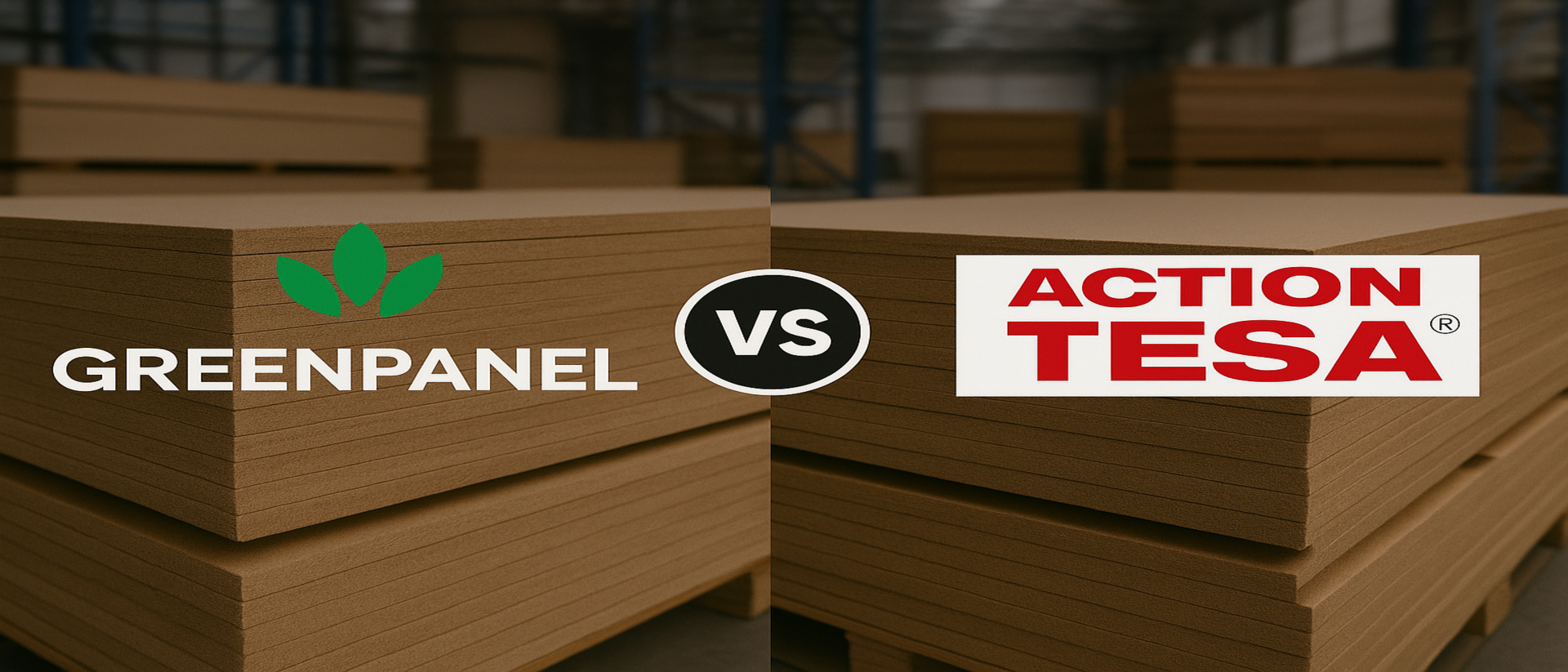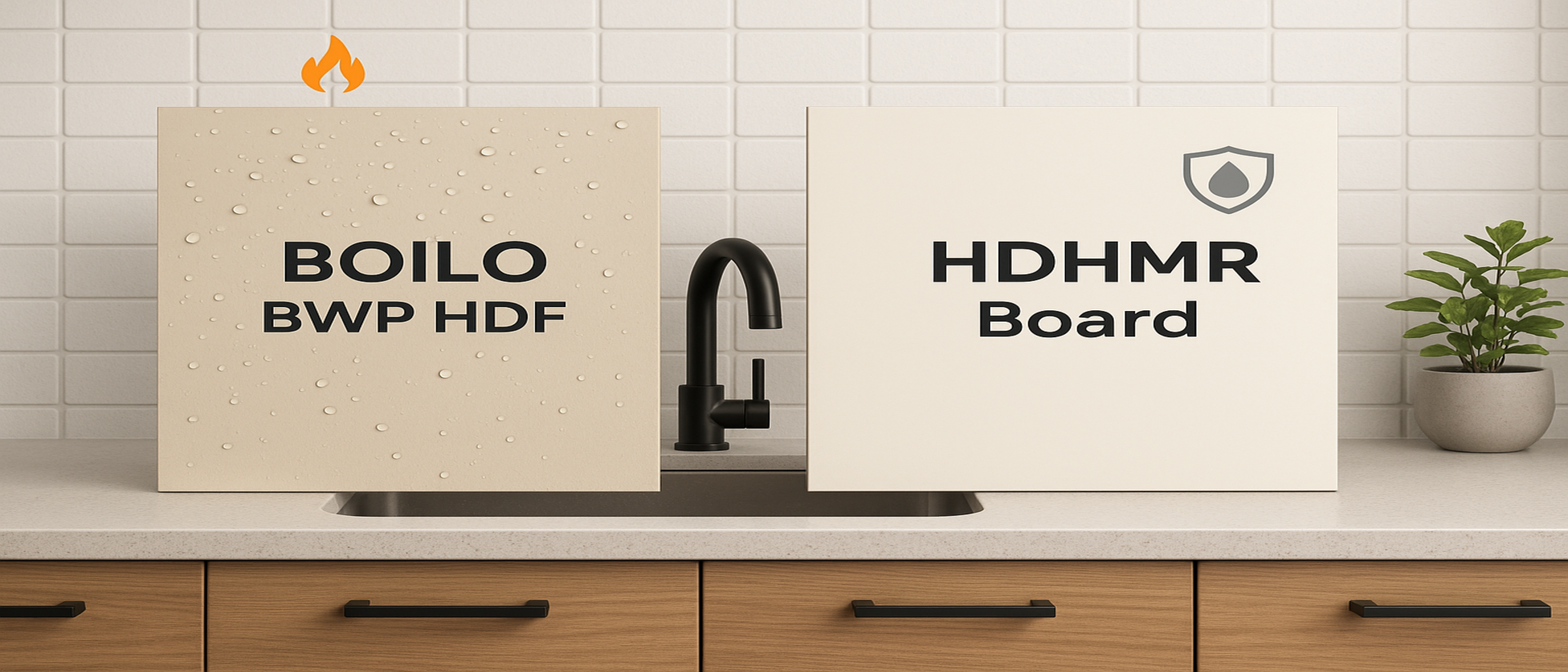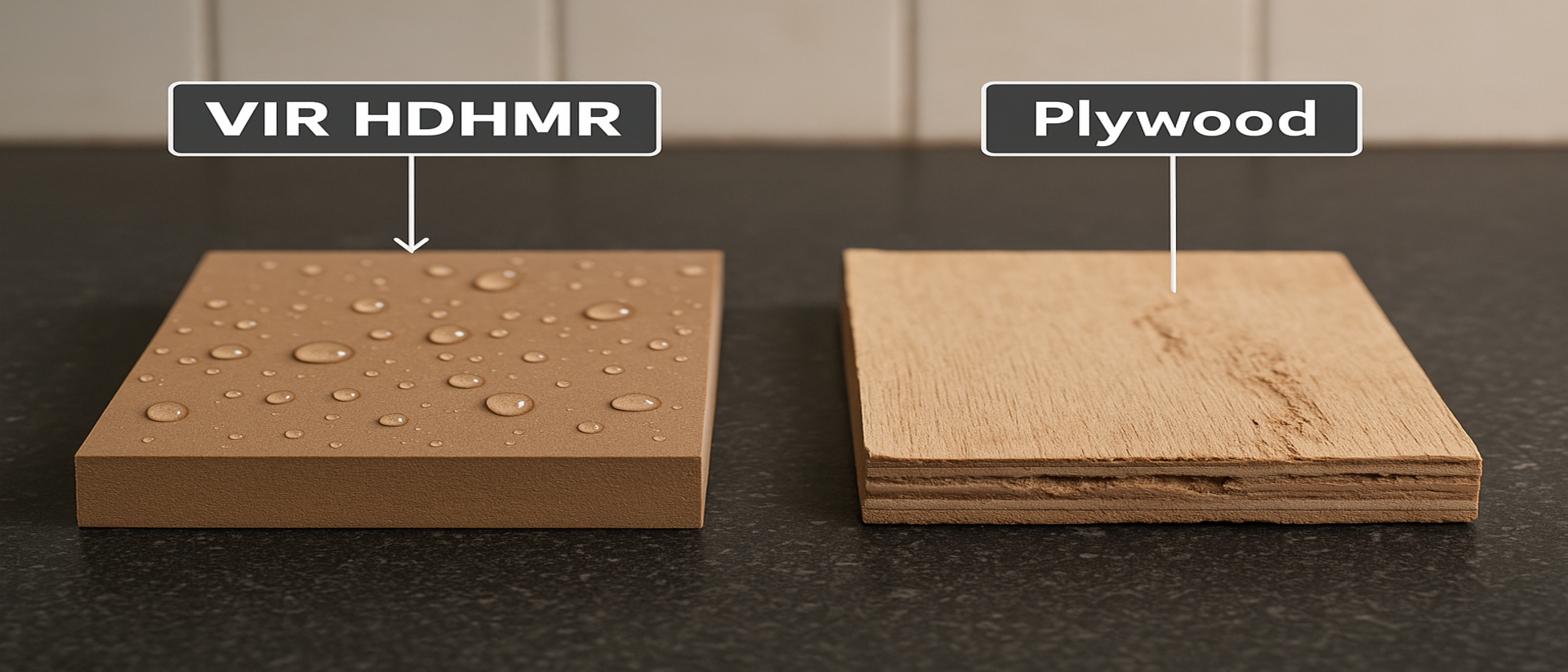Introduction
When building furniture or doors, HDHMR board and blockboard are two popular options. HDHMR (High Density High Moisture Resistant) is an engineered fiberboard known for uniform strength and water resistance. Blockboard has a core of wood strips with veneer faces, giving it high rigidity across long spans. Both are stiffer than regular plywood of the same thickness. This comparison examines their 2025 technical specs, as well as their durability, applications, and cost differences. Understanding these helps you decide whether HDHMR or blockboard best suits your specific furniture or cabinetry needs.
2025 Technical Specs & Price Comparison
· Composition & Density: HDHMR is a dense fiberboard (~850 kg/m³). Blockboard is plywood-like: it’s made of softwood strips (battens) glued edge-to-edge, with thin hardwood veneers on faces. Its density varies with wood type (softwood blockboard is lighter). Overall, HDHMR has more uniform density, while blockboard can have voids between strips.
· Strength & Screw Holding: Blockboard’s solid strip core gives excellent screw withdrawal strength (better than MDF). It is noted for superior load-bearing over long spans: a blockboard shelf won’t sag like plywood. HDHMR’s strength is also high, but it’s typically used in thick panels; its screw holding is excellent in the core and edges due to uniform fibers. According to a comparison, blockboard is “extremely durable” for indoor furniture, but HDHMR outperforms it under humid conditions.
· Moisture Resistance: HDHMR has a significant advantage: it is engineered to resist moisture and won’t swell easily. Blockboard’s core (softwood strips) is prone to absorbing water, so standard blockboard should be well-sealed. (Marine/blockboard variants exist for wet use, but normal blockboard is for dry interiors.)
· Weight: HDHMR boards are quite heavy for their thickness. Blockboard, especially softwood type, is relatively lighter because wood battens are lighter than a solid fiber core. This makes blockboard easier to move large sheets.
· Price (2025): Blockboard generally costs less than HDHMR. A 25mm blockboard sheet (8×4 ft) is often around ₹90–122 per sqft. HDHMR (being a premium fiberboard) is around ₹80–120 per sqft for similar thickness. If comparing 19mm thickness, blockboard can be somewhat cheaper per sheet than an equivalent HDHMR board.
Strengths & Weaknesses of Each Material
HDHMR Board
· Strengths: HDHMR offers uniform high strength and rigidity. Its smooth, homogeneous surface makes laminating or painting easy. It resists moisture and termites, so it won’t warp or rot in humid conditions.
· Weaknesses: HDHMR boards are heavy and dense, which can make handling and installation more cumbersome. They can also be brittle if over-bent (no internal flex). HDHMR lacks the natural wood veneer aesthetic (though it can be laminated with wood-grain finishes). It is more expensive than blockboard when both are compared as pure wood-based materials.
Blockboard
· Strengths: Blockboard’s main advantage is stability over long spans. A long shelf or tabletop made of blockboard will remain straight and not sag. It has excellent screw-holding along the edges and core, and it’s lighter than plywood or HDHMR. Blockboard is easy to work with using standard carpentry tools. In furniture, it’s praised for being “strong and durable for indoor furniture, especially long pieces”. It also tends to cost less, making it a budget-friendly sturdy option.
· Weaknesses: Standard blockboard has poor moisture resistance. Exposure to dampness will cause its core strips to expand and delaminate unless sealed. It also uses more glue (urea-formaldehyde) in its core, which may emit more VOCs than HDHMR’s melamine resin. Visually, blockboard requires veneering/lamination to achieve a finished look (as the core is not polished). It’s not meant for exterior or very humid environments unless specified as BWP/BWR grade blockboard.
Durability & Moisture Resistance
HDHMR boards are specifically designed to endure moisture; they barely swell when exposed to humidity. In contrast, blockboard (especially MR-grade) can absorb water through veneer joints and expand. For durability: HDHMR is superior in kitchens and bathrooms. Blockboard is durable for dry indoor furniture (beds, wardrobes) and lasts as long as plywood in those uses. A helpful analogy: use HDHMR like you’d use marine plywood (indoors), and blockboard like you’d use regular plywood – great structural strength, but not in wet conditions without treatment. If a blockboard item accidentally gets wet, it will degrade much faster than an HDHMR one.
Applications / Best Use Cases
· HDHMR: Opt for HDHMR in high-moisture or heavy-duty furniture. Examples: kitchen cabinets, bathroom vanities, wardrobe internals, moisture-prone office desks. Also for doors and partitions in humid locations. Its high screw capacity and stability make it ideal for any indoor furniture expected to last decades.
· Blockboard: Best used for long, wide furniture pieces in dry areas. Common applications include bedroom wardrobes, bookshelves, tables, and interior doors. It’s perfect when you need a large, flat panel without mid-support (e.g. a 10-ft bookshelf top). Also used in shutters and partitions. Avoid using blockboard in bathrooms or kitchens unless it’s an MR/BWR blockboard with water-resistant core.
Cost Analysis & Value for Money
Blockboard has a cost advantage: because it uses softwood strips, it can be 10-20% cheaper than HDHMR for the same size panel. You pay more for HDHMR’s engineered uniformity and moisture-proofing. However, HDHMR may be “more affordable than high-grade plywood” while offering similar moisture performance. The choice depends on priorities: blockboard can lower material costs on large runs of furniture. HDHMR may slightly increase budget but reduces risk of water damage and replacement later. For example, if building a large wardrobe in a damp region, spending extra on HDHMR gives peace of mind and longevity.
Buyer’s Checklist: Which to Choose?
· Humidity: If your furniture might face humidity or splashes (kitchen cabinets, bathroom storage), choose HDHMR. If it’s a bedroom dresser or office shelf (dry use), blockboard is fine.
· Load Span: For very long spans (10+ feet, e.g. long shelves), blockboard resists bending better. HDHMR is also strong but costs more for the same panel size.
· Weight/Handling: Blockboard sheets are lighter and easier to maneuver on site. HDHMR is heavy – make sure you have assistance for large sheets.
· Finish: Blockboard cores look natural (wood grain) under veneer; HDHMR’s core is uniform fiber. Choose blockboard if you want a “real wood” cross-section appearance. Both should be laminated for surface finish.
· Cost: Blockboard provides a cost-effective sturdy panel (especially in MR-grade for moderate moisture). HDHMR is an investment for extreme conditions. Balance budget vs performance.
· Health/Safety: If low formaldehyde emissions are needed, HDHMR (with MUF resin) may offer E1/E0 grades. Some blockboards emit more due to higher glue usage. Always ask for E0-certified options.
FAQs
Q1: Can blockboard replace HDHMR in a kitchen?
No. Blockboard (even MR-grade) will absorb moisture over time, especially at joints. HDHMR is specifically made for kitchens and bathrooms. For countertops or cabinet boxes, HDHMR or plywood is safer for water resistance.
Q2: Which is stronger, HDHMR or blockboard?
Both are strong, but in slightly different ways. HDHMR is stronger per thickness and handles screws better. Blockboard is better at resisting bending over very long spans. For a given thickness, HDHMR may actually have higher bending strength due to its density.
Q3: How do they compare in weight?
HDHMR is generally heavier (higher density). A 12mm HDHMR sheet can weigh about 9–11 kg (8×4 ft). A 12mm softwood blockboard of same size might weigh ~7–8 kg, making it easier to lift and install.
Q4: Is blockboard good for flooring?
No. Blockboard is not typically used for flooring. It’s not made for foot traffic or moisture. HDHMR also isn’t used for floors (that’s what HDF laminate flooring cores or WPC floors are for). For flooring, use proper engineered wood or WPC designed panels.
Q5: What about termite resistance?
Both HDHMR and blockboard use treatments, but HDHMR’s resin content gives it an edge against termites. Blockboard uses plantation softwood strips which are susceptible unless specially treated. HDHMR is the safer choice in termite-prone areas.
Q6: Which is cheaper per piece?
Blockboard is usually cheaper. For example, a 25mm blockboard sheet is often sold at ₹90–122/sqft, whereas HDHMR at similar thickness can be ₹100–130/sqft. Prices vary by brand and grade, but blockboard tends to cost less overall.
Conclusion
HDHMR and blockboard both serve structural purposes but fit different roles. Use blockboard for large dry-area furniture requiring long spans – it’s stiff, lightweight, and cost-effective. Use HDHMR for any moisture-exposed or heavy-duty cabinetry – it offers uniform strength and water resistance that blockboard lacks. By understanding these differences, you can choose the board that suits your furniture’s environment and functional needs. For expert advice on HDHMR or blockboard for your project, contact us and our specialists will help you pick the perfect material.
Disclaimer: This article is generated using AI-assisted research and is intended for informational purposes only. While we strive for accuracy, readers are advised to verify all technical, pricing, and brand-specific details with official sources. hdhmr.in is not liable for any decisions made based on this content.




